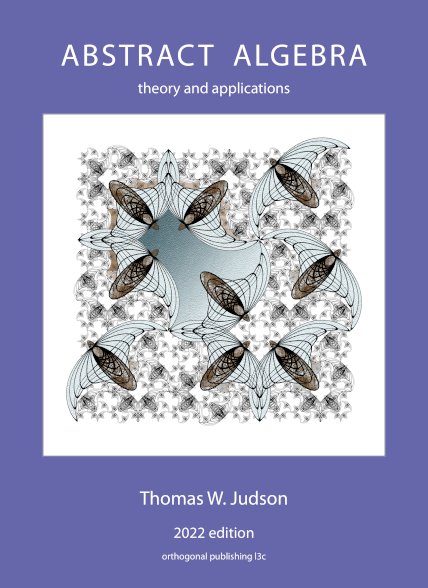Section 9.5 Sage
Sage has limited support for actually creating isomorphisms, though it is possible. However, there is excellent support for determining if two permutation groups are isomorphic. This will allow us to begin a little project to locate all of the groups of order less than
Subsection Isomorphism Testing
If
G and H are two permutation groups, then the command G.is_isomorphic(H) will return True or False as the two groups are, or are not, isomorphic. Since “isomorpic to” is an equivalence relation by Theorem 9.10, it does not matter which group plays the role of G and which plays the role of H.So we have a few more examples to work with, let us introduce the Sage command that creates an external direct product. If
G and H are two permutation groups, then the command direct_product_permgroups([G,H]) will return the external direct product as a new permutation group. Notice that this is a function (not a method) and the input is a list. Rather than just combining two groups in the list, any number of groups can be supplied. We illustrate isomorphism testing and direct products in the context of Theorem 9.21, which is an equivalence, so tells us exactly when we have isomorphic groups. We use cyclic permutation groups as stand-ins for First, two isomorphic groups.
xxxxxxxxxxm = 12n = 7gcd(m, n)xxxxxxxxxxG = CyclicPermutationGroup(m)H = CyclicPermutationGroup(n)dp = direct_product_permgroups([G, H])K = CyclicPermutationGroup(m*n)K.is_isomorphic(dp)Now, two non-isomorphic groups.
xxxxxxxxxxm = 15n = 21gcd(m, n)xxxxxxxxxxG = CyclicPermutationGroup(m)H = CyclicPermutationGroup(n)dp = direct_product_permgroups([G, H])K = CyclicPermutationGroup(m*n)K.is_isomorphic(dp)Notice how the simple computation of a greatest common divisor predicts the incredibly complicated computation of determining if two groups are isomorphic. This is a nice illustration of the power of mathematics, replacing a difficult problem (group isomorphism) by a simple one (factoring and divisibility of integers). Let us build one more direct product of cyclic groups, but with three groups, each with orders that are pairwise relatively prime.
If you try the following with larger parameters you may get an error (
database_gap).xxxxxxxxxxm = 6n = 5r = 7G = CyclicPermutationGroup(m)H = CyclicPermutationGroup(n)L = CyclicPermutationGroup(r)dp = direct_product_permgroups([G, H, L])K = CyclicPermutationGroup(m*n*r)K.is_isomorphic(dp)Subsection Classifying Finite Groups
Once we understand isomorphic groups as being the “same”, or “fundamentally no different,” or “structurally identical,” then it is natural to ask how many “really different” finite groups there are. Corollary 9.9 gives a partial answer: for each prime there is just one finite group, with
Let us embark on a quest to find all the groups of order less than
xxxxxxxxxx[CyclicPermutationGroup(p) for p in [1, 2, 3, 5, 7, 11, 13]]So now our smallest unknown case is order
xxxxxxxxxxG = CyclicPermutationGroup(4)H = KleinFourGroup()T1 = CyclicPermutationGroup(2)T2 = CyclicPermutationGroup(2)K = direct_product_permgroups([T1, T2])G.is_isomorphic(H)xxxxxxxxxxH.is_isomorphic(K)So we have at least two different groups:
We have seen at least two groups of order
xxxxxxxxxxG = CyclicPermutationGroup(6)H = SymmetricGroup(3)G.is_isomorphic(H)Is that all? There is
xxxxxxxxxxG = DihedralGroup(3)H = SymmetricGroup(3)G.is_isomorphic(H)
Exercise 9.4.55 from this section classifies all groups of order
By this general result, in addition to order
Subsection Internal Direct Products
An internal direct product is a statement about subgroups of a single group, together with a theorem that links them to an external direct product. We will work an example here that will illustrate the nature of an internal direct product.
Given an integer
Integers(n) where we can add and multiply, but we want to stay strictly with multiplication only.First we build the subgroup itself. Notice how we must convert
x into an integer (an element of ZZ) so that the greatest common divisor computation performs correctly.xxxxxxxxxxZ36 = Integers(36)U = [x for x in Z36 if gcd(ZZ(x), 36) == 1]USo we have a group of order
xxxxxxxxxx[x.multiplicative_order() for x in U]We have many choices for generators of a cyclic subgroup of order
U so that they are sure to be elements of Z36 and behave properly when multiplied.xxxxxxxxxxa = U[1]A = [a^i for i in srange(6)]Axxxxxxxxxxb = U[11]B = [b^i for i in srange(2)]BSo
A and B are two cyclic subgroups. Notice that their intersection is the identity element, one of our requirements for an internal direct product. So this is a good start.xxxxxxxxxx[x for x in A if x in B]Z36 is an abelian group, thus the condition on all products commuting will hold, but we illustrate the Sage commands that will check this in a non-abelian situation.xxxxxxxxxxall([x*y == y*x for x in A for y in B])Finally, we need to check that by forming products with elements from
A and B we create the entire group. Sorting the resulting list will make a check easier for us visually, and is required if we want Sage to do the check.xxxxxxxxxxT = sorted([x*y for x in A for y in B])TxxxxxxxxxxT == UThat’s it. We now condense all this information into the statement that “
U is the internal direct product of A and B.” By Theorem 9.27, we see that U is isomorphic to a product of a cyclic group of order U is no more or less complicated than U. For example, we can see that U is not cyclic, since when written as a product of cyclic groups, the two orders are not relatively prime. The final expression of U suggests you could find three cyclic subgroups of U, with orders U is an internal direct product of the three subgroups.
